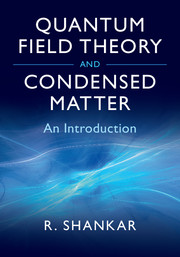Book contents
- Frontmatter
- Dedication
- Contents
- Preface
- 1 Thermodynamics and Statistical Mechanics Review
- 2 The Ising Model in d = 0 and d = 1
- 3 Statistical to Quantum Mechanics
- 4 Quantum to Statistical Mechanics
- 5 The Feynman Path Integral
- 6 Coherent State Path Integrals for Spins, Bosons, and Fermions
- 7 The Two-Dimensional Ising Model
- 8 Exact Solution of the Two–Dimensional Ising Model
- 9 Majorana Fermions
- 10 Gauge Theories
- 11 The Renormalization Group
- 12 Critical Phenomena: The Puzzle and Resolution
- 13 Renormalization Group for the ϕ4 Model
- 14 Two Views of Renormalization
- 15 Renormalization Group for Non-Relativistic Fermions: I
- 16 Renormalization Group for Non-Relativistic Fermions: II
- 17 Bosonization I: The Fermion–Boson Dictionary
- 18 Bosonization II: Selected Applications
- 19 Duality and Triality
- 20 Techniques for the Quantum Hall Effect
- Index
- References
10 - Gauge Theories
Published online by Cambridge University Press: 24 October 2017
- Frontmatter
- Dedication
- Contents
- Preface
- 1 Thermodynamics and Statistical Mechanics Review
- 2 The Ising Model in d = 0 and d = 1
- 3 Statistical to Quantum Mechanics
- 4 Quantum to Statistical Mechanics
- 5 The Feynman Path Integral
- 6 Coherent State Path Integrals for Spins, Bosons, and Fermions
- 7 The Two-Dimensional Ising Model
- 8 Exact Solution of the Two–Dimensional Ising Model
- 9 Majorana Fermions
- 10 Gauge Theories
- 11 The Renormalization Group
- 12 Critical Phenomena: The Puzzle and Resolution
- 13 Renormalization Group for the ϕ4 Model
- 14 Two Views of Renormalization
- 15 Renormalization Group for Non-Relativistic Fermions: I
- 16 Renormalization Group for Non-Relativistic Fermions: II
- 17 Bosonization I: The Fermion–Boson Dictionary
- 18 Bosonization II: Selected Applications
- 19 Duality and Triality
- 20 Techniques for the Quantum Hall Effect
- Index
- References
Summary
We now study a family of models that are bizarre in the following sense: all the correlation functions you would naively think of vanish identically. Yet these models have meaningful parameters like temperature, and even exhibit phase transitions. More importantly, the electromagnetic, weak, and strong interactions are described by such gauge theories. So we have to take them very seriously. This chapter is only a brief introduction to this vast subject and its novel features, aimed at preparing you for more advanced and exhaustive treatments. Although many references will be furnished along the way, the review article by J. Kogut [1] will come in handy everywhere.
Gauge theories can be constructed on the lattice or the continuum. We only consider the lattice version here. In the modern view, even continuum versions must first be defined on a lattice, whose spacing must be made to vanish in a certain limiting process. The continuum Majorana theory that came from the Ising model is an example. It is, however, a trivial example because the final continuum theory describes free fermions. Defining interacting theories in the continuum will require the identification and detailed description of a more complicated second-order phase transition. It will also require the use of the renormalization group, to be described later.
Why would one dream up a model with no order parameter in statistical mechanics? The motivation comes from the XY model, which one can show has no order parameter and yet at least two phases. Let us simply follow it far enough to understand the notion of phase transitions without an order parameter, a point made by Stanley and Kaplan [2]. It will teach us a way to classify phases without referring to the order parameter.
The XY Model
Let us recall how we know the Ising model (in d > 1) has two phases. At high temperatures, the tanhK expansion shows exponentially decaying correlation functions. The magnetization M(T), given by the square root of the asymptotic two-point function, vanishes. The expansion has a finite, non-zero radius of convergence. At low T, the spins start out fully aligned M(0)=1 and get steadily disordered as T increases (for d >1). This expansion also has a non-zero radius. If M(T) is non-zero in one range and identically zero in another, it must be singular somewhere. There must be at least one phase transition in T.
- Type
- Chapter
- Information
- Quantum Field Theory and Condensed MatterAn Introduction, pp. 157 - 182Publisher: Cambridge University PressPrint publication year: 2017

